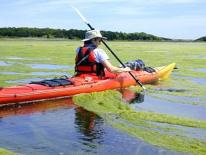
Background
Algae and cyanobacteria, also known as blue-green algae, are found naturally in aquatic environments and are an essential part of the ecosystem. Algae are major sources of food for aquatic life and create oxygen that fish use. Algae blooms occur when large amounts of algae are present in a water body. They can sometimes be observed as floating mats on the water surface or simply as a change in water color.
Although algae blooms are natural events, they can be accelerated by manmade factors. Some conditions that promote algal growth include slow-moving water, warm temperatures, and the easy availability of nutrients. Fertilizers, animal waste, sewage discharges, and stormwater runoff increase the availability of nutrients such as nitrogen and phosphorus and enhance conditions for algal growth.
While many forms of algae do not cause direct harm, some forms of algae and cyanobacteria can present health risks to wildlife, pets, or humans. An overabundance of algae or cyanobacteria can harm aquatic ecosystems by preventing light from reaching other plants below the water surface. Without sunlight, the submerged plants will not survive and will no longer provide food or habitat for fish. Large algae blooms can also deplete oxygen levels in the water as they die off. With low oxygen levels, fish cannot survive and the result may be a fish kill event.
Algae Bloom Monitoring
DOEE staff conducts regular surveillance and sampling to track the water conditions of the District’s rivers and streams. DOEE analyzes continuous, real-time water quality measurements of Chlorophyll from the Potomac and Anacostia Rivers to monitor for algae and cyanobacteria blooms.
Algae Bloom Safety
Blooms that have a negative impact on the environment are called Harmful Algal Blooms (HABs). Take caution to limit any exposure to a suspected HAB. Several species of cyanobacteria have the capacity to produce toxic chemicals that can harm human health and lead to illness or death for wildlife and pets. People and pets should avoid direct skin contact, inhalation, or ingestion of water affected by HABs.
Reporting Suspected Algae Blooms or Harmful Algal Blooms 
To report suspected large algae blooms or HABs, please contact DOEE at [email protected]. Please include your name, phone number, the location of the algae bloom, and the date and time you observed it. If possible, please also include the approximate size of the bloom and a photo of the site.
You may also submit information on suspected algae blooms in the District via app! The bloomWatch app allows users to easily capture photos and GPS location data of potential algae blooms using a smartphone or tablet and then share data with other citizen scientists and DOEE. For further information or to download the app, visit bloomWatch.
For More Information

